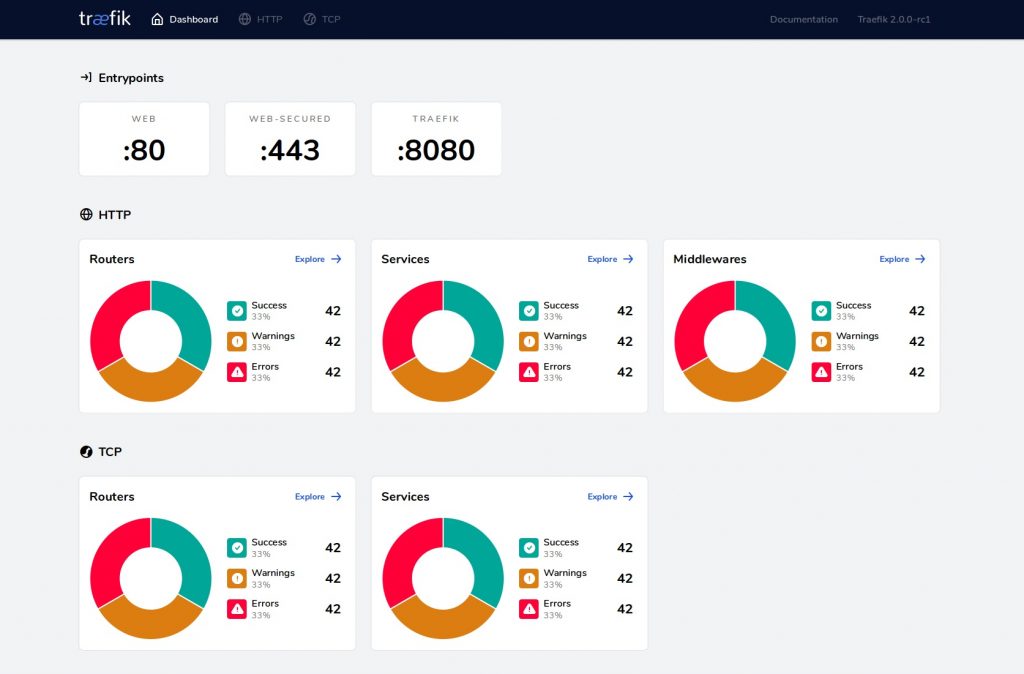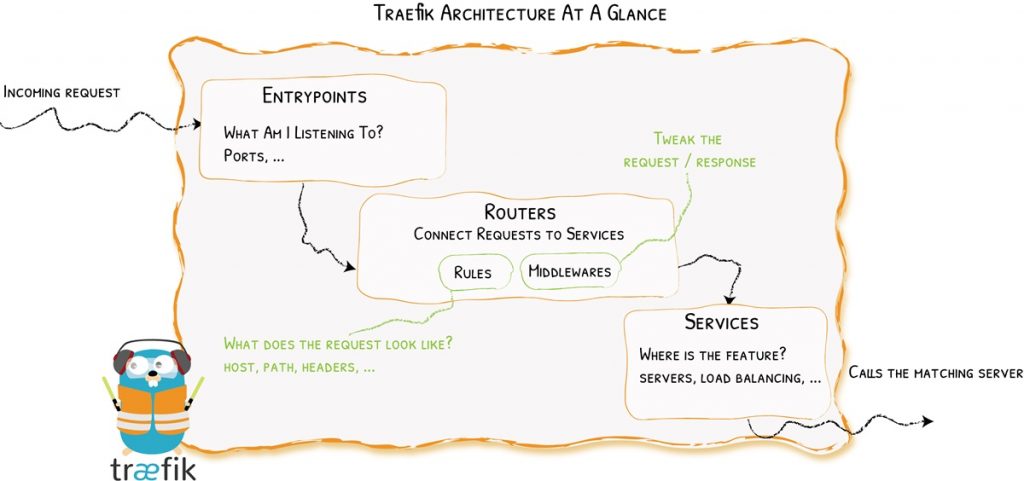One of the most prominent tool comparisons in web traffic management is Traefik vs NGINX. Both are cornerstones in building efficient, scalable, and secure web applications. Today, we’ll compare them and see how far similarity ends at purpose.
Table of Contents
- What are Traefik and NGINX?
- Design and Architecture
- Performance: Agility vs Raw Power
- Traefik vs NGINX Configuration and Management
- Security Features
- Pricing and Licensing
- Use Cases
- Final Thoughts and References
What are Traefik and NGINX?
Traefik and NGINX are both web server applications. They also serve other purposes, such as load balancing and reverse proxy. This allows excellent flexibility, enabling them to support a broader user base.
Despite these similarities, the most obvious difference in Traefik vs NGINX is their significant diversion in solution approach and ideal use cases.
Traefik is known for its dynamic configuration capabilities and ease of use. It caters to modern containerized environments. On the other hand, NGINX is robust and reliable, prized for performance, stability, and precise configuration options.
a. Traefik: The Cloud-Native Proxy

Traefik is a web application that’s often heralded as a cloud-native proxy. It is explicitly designed for microservices architectures and modern, containerized environments. It boasts dynamic configuration capability, allowing it to adapt to environment changes automatically.
The design of Traefik allows it to integrate seamlessly with platforms like Kubernetes, Docker, and Mesos. It can automatically discover services and route traffic accordingly. This automation reduces the administrative overhead associated with manual configuration updates.
b. NGINX: The High-Performance Web Server
Perhaps a better-known name than others, NGINX has built its reputation as a formidable web server. It can handle a massive load of concurrent connections. More importantly, NGINX now fills many other roles, including as a reverse proxy and load balancer.
In a comparison of Traefik vs NGINX, the latter relies on a more static configuration system. This demands manual setup but offers better control. The approach makes NGINX highly predictable, stable, and capable of handling large traffic volumes.
Looking for easy-to-use Proxy servers?
Get fully optimized IPv4 and IPv6 proxies for any use. RapidSeedbox offers cost-effective proxy servers that are fast and stable.
————
2. Design and Architecture
| Traefik | NGINX | |
| Design Principle | Dynamic and automatic service discovery. | Static configuration and high-performance handling. |
| Configuration Model | Automatic, dynamic configuration | Manual, static configuration |
| Environment Suitability | Best for dynamic, containerized, and microservices environments. | Ideal for high-traffic, stable environments requiring precise control. |
| Integration with Container Orchestration | Built-in support for Kubernetes, Docker, Mesos. | Can be integrated but lacks native, automatic discovery. |
| Performance Optimization | Optimized for quick adaptability rather than raw performance. | Highly optimized for performance and efficiency. |
| Manual Intervention | Minimal; changes are handled automatically. | Significant; requires manual updates for changes. |
Traefik and NGINX are built on fundamentally different architectural principles. These differences cater to distinct use cases, making the choice between them biased to the needs of a web application’s infrastructure.

a. How Traefik Architecture Works
Traefik’s architecture offers a solution that reduces administrative overhead and embraces the fluidity of modern, microservices-based environments. Its ability to auto-configure and adapt to changes in real time aligns well with agile development needs.
From a top-down view, Traefik acts as a reverse proxy. It manages incoming requests and routes them to appropriate backend services. This is done using rules and filters to determine where to send each request.
b. How NGINX Architecture Works
With its emphasis on manual configuration and optimization, NGINX appeals to scenarios where stability, performance, and control are paramount. Its architecture is favored in environments where changes are less frequent.
This design is centered around a single configuration file, nginx.conf. The file contains directives organized into contexts (like HTTP, server, and location) that dictate how requests are processed and routed.
3. Performance: Agility vs Raw Power
| CPUs | 0 KB | 1 KB | 10 KB | 100 KB |
| 1 | 71,561 | 40,207 | 23,308 | 4,830 |
| 2 | 151,325 | 85,139 | 48,654 | 9,871 |
| 4 | 324,654 | 178,395 | 96,808 | 19,355 |
| 8 | 647,213 | 359,576 | 198,818 | 38,900 |
| 16 | 1,262,999 | 690,329 | 383,860 | 77,427 |
| 32 | 2,197,336 | 1,207,959 | 692,804 | 90,430 |
| 36 | 2,175,945 | 1,239,624 | 733,745 | 89,842 |
The choice between Traefik vs NGINX from a performance perspective depends on the specific requirements and operational context. NGINX brings proven performance to the table for static environments or where high throughput efficiency is paramount.
On the other hand, Traefik shows adequate handling but has better flexibility. This makes it a better option for dynamic environments where the application landscape constantly changes. It can reduce the operational overhead associated with managing service scalability.
Note: According to benchmarks, Traefik v3.0.0 handled 74,019 requests per second. On the same platform, NGINX v1.23.4 handled 100,622 requests per second. Latency on Traefik was also higher by 3ms on average. NGINX also had almost twice the throughput capacity.
While NGINX might be the go-to for scenarios demanding the highest performance levels, Traefik may be a better choice considering the shift toward more modern, cloud-native applications.
From a scalability aspect, both of these applications are future-proofed with support for IPv6. That will ensure you can support all the IP addresses you need.
4. Traefik vs NGINX Configuration and Management
| Traefik | NGINX | |
| Configuration | Dynamic, automatic based on services | Static, manual configuration files |
| Orchestration Tools | Built-in support for Kubernetes, Docker Swarm, etc. | Possible through third-party modules and manual setup. |
| Management Interface | Dashboard and web UI for real-time monitoring. | Primarily command-line (GUI in NGINX Plus). |
| Manual Effort | Minimal | Significant, especially in environments with frequent changes. |
| Control and Precision | Optimized for ease rather than fine-grained control. | High, with extensive configuration options. |
| Automation and Tools Support | Supports REST API for integration with automation tools. | Compatible with configuration management tools like Ansible, Chef, and Puppet. |
So far, we’ve seen that in a comparison of Traefik vs NGINX, it’s obvious they are designed for different operational environments. However, both can integrate with configuration management and automation tools to streamline deployment and updates.
Traefik’s REST API and NGINX’s configuration files can be managed through tools like Ansible, Chef, or Puppet. This allows teams to automate and version control their configuration changes easily. The capability is especially notable for NGINX since it can mitigate some manual efforts.
Meanwhile, Traefik’s dynamic capabilities allow distinct leverage within controlled, repeatable deployment processes.
5. Security Features
| Traefik | NGINX | |
| Automatic HTTPS | Automated certificate management with Let’s Encrypt. | Manual setup but offers extensive configuration options. |
| Security Middlewares / Modules | Built-in middleware for rate limiting, basic authentication, secure headers, etc. | Modules for security headers, CSP, and more advanced configurations. |
| Authentication Support | clientAuth, middleware for additional methods. | Multiple methods, including JWT and OAuth. |
| SSL/TLS Configuration Control | Less granular control but highly automated. | Highly granular control over encryption settings and performance. |
| Rate Limiting and Access Control | Via middleware | Advanced rate limiting and detailed access controls. |
| Security Logging | Detailed access logs for monitoring and analysis. | Access and error logs for comprehensive traffic monitoring. |
It should be no surprise that comparing Traefik vs NGINX in security can be challenging. They both bring robust security capabilities to the table.
Traefik’s ability to dynamically apply security policies aligns well with modern needs. This is remarkably relevant to its prime purpose in serving microservices-based applications. The relatively hands-off approach can also drastically reduce support requirements.
NGINX’s approach provides a higher degree of control and customization. This can appeal in scenarios where detailed security configurations and optimizations are essential. It extensively supports authentication mechanisms and the ability to fine-tune SSL/TLS settings.
6. Pricing and Licensing
In comparing Traefik vs NGINX it’s essential to understand that they offer versatile pricing and licensing models. This allows them to accommodate various business needs.
It must be noted that regardless of choice, close Total Cost of Ownership evaluation is vital whenever dedicated support is necessary. The key reason is that both applications offer open-source and commercial variations.
a. How Much Will Traefik Cost?
The open-source version, Traefik Proxy, is available under the MIT License. This allows broad usage in commercial and non-commercial projects. It provides the core functionality needed for dynamic configuration and load balancing.
Traefik Enterprise starts at $5,000 per year per instance. It is meant for organizations requiring advanced features like single sign-on (SSO), enhanced security, and technical support. Pricing is based on the deployment scale and the necessary level of support.
b. How Much Will NGINX Cost?
The core of NGINX is available as an open-source project under the 2-clause BSD License. While free, this version is robust and sufficient for many use cases. That includes reverse proxying, load balancing, and content caching.
NGINX Plus is a commercial solution that starts at $3,675 per year per instance. It includes expert support and features like health checks, session persistence, JWT authentication, and a web-based management dashboard.
7. Use Cases
This section explores typical use cases for Traefik vs NGINX. It’s crucial to understand how they can best serve different scenarios.
When to Use Traefik
Traefik shines in environments that demand flexibility and ease of configuration, particularly in containerized and microservices architectures. Its automatic service discovery and configuration capabilities make it an ideal choice for the following scenarios:
- Containerized Environments: Traefik automatically adjusts routing rules as containers are created or destroyed, simplifying network traffic management in dynamic cloud environments.
- Microservices Architectures: Traefik is a strong candidate for microservices architectures, where services frequently change and scalability is critical. Support for multiple protocols allows for versatile microservices communication.
- Development and Testing Environments: For development teams adopting continuous integration and delivery (CI/CD) practices, Traefik’s ease of configuration and deployment can significantly reduce setup times and facilitate testing processes.
When to Use NGINX
NGINX, with its focus on performance and fine-grained configuration control, is particularly practical in scenarios that require high efficiency and reliability:
- High-Traffic Websites: Event-driven architecture enables it to handle thousands of concurrent connections with minimal resource usage. It is preferred for high-traffic websites and applications seeking to maximize performance.
- Static Content Delivery: For serving static content, NGINX’s efficient file handling and caching mechanisms can significantly improve load times, enhancing the user experience.
- Load Balancing for Traditional Applications: In environments with stable services and endpoints, NGINX’s manual configuration approach allows for precise control over load balancing strategies, optimizing resource utilization.
- Security and Compliance: Organizations with stringent security requirements may favor NGINX’s extensive SSL/TLS configuration options. It allows complex access control and authentication schemes.
tl;dr: Traefik and NGINX are excellent web server applications in their own right. However, Traefik is aimed toward more modern containerized environments. Meanwhile, NGINX remains a tried and tested solution that’s highly robust.
8. Final Thoughts
While there are applications with similar purposes, it’s essential to consider aligning technical differences to specific operational contexts and objectives. This consideration comes to the forefront when choosing between Traefik and NGINX.
Traefik, with its dynamic configuration and ease of use, excels in rapidly evolving environments. On the other hand, NGINX stands out for its performance efficiency, stability, and fine-grained control, making it ideal for high-traffic websites with static content delivery.
While you may get away with either application at low utility values, the overall operational cost can vary significantly at higher volumes. Once that happens, any migration may cost remarkably more than you expect.
Do you need more IP address space?
RapidSeedbox offers IPv4 and IPv6 address rental services. Enjoy excellent customer support 24/7. You can deploy the IP addresses via our servers or get an LOA for your data center.
————
References
- Johansson, Alfred. “Http load balancing performance evaluation of haproxy, nginx, traefik and envoy with the round-robin algorithm.” (2022).
- Sharma, Rahul, et al. “Introduction to Traefik.” Traefik API Gateway for Microservices: With Java and Python Microservices Deployed in Kubernetes (2021).
- Calsin Quinto, Edwin R., A. Angel Sullon, and Fredy Abel Huanca Torres. “Reference Method for Load Balancing in Web Services with REST Topology Using Edge Route Tools.” Proceedings of Sixth International Congress on Information and Communication Technology: ICICT 2021, London, Volume 4. Singapore: Springer Singapore, 2021.
- Li, Junfeng, et al. “Analyzing open-source serverless platforms: Characteristics and performance.” arXiv preprint arXiv:2106.03601 (2021).
- Qin, E., et al. “Research on nginx dynamic load balancing Algorithm.” 2020 12th International Conference on Measuring Technology and Mechatronics Automation (ICMTMA). IEEE, 2020.

0Comments